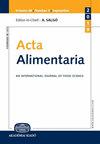Optimisation of microencapsulation efficiency of propolis phenolic compounds by double emulsion method using response surface methodology
IF 1
4区 农林科学
Q4 FOOD SCIENCE & TECHNOLOGY
引用次数: 0
Abstract
The aim of this study was to optimise the microencapsulation efficiency of propolis phenolic compounds by double emulsion solvent evaporation technique (W1/O/W2). The solvent/sample ratio and the polymer and surfactant concentration parameters were optimised using response surface methodology (RSM) through Box–Behnken Design (BBD). For each parameter studied, total phenolic content encapsulation efficiency (TPCEE), free radical scavenging activity (DPPH), and ferric reducing antioxidant power (FRAP) were evaluated. The results showed that the optimal parameters were: 31.60 mg mL−1 for sample/solvent ratio, 606.28 mg mL−1 for poly(ε-caprolactone) (PCL) concentrations, and 2.05 g mL−1 for poly(vinyl alcohol) (PVA) concentration. The optimum values obtained were: 84.62% for encapsulation efficiency of phenolic content, 51.89% for DPPH, and 48,733 mg Trolox Equivalent/100 g dry weight for FRAP. The experimental checking of results revealed the validity of elaborated models and their suitability for the prediction of both responses. The developed mathematical models have expressed a high level of significance through RSM optimisation processes for phenolic antioxidants of propolis.利用响应面方法优化双乳液法蜂胶酚类化合物的微胶囊效率
本研究旨在通过双乳液溶剂蒸发技术(W1/O/W2)优化蜂胶酚类化合物的微胶囊效率。通过箱-贝肯设计(BBD),采用响应面方法(RSM)对溶剂/样品比、聚合物和表面活性剂浓度参数进行了优化。对所研究的每个参数进行了评估,包括总酚含量封装效率(TPCEE)、自由基清除活性(DPPH)和铁还原抗氧化能力(FRAP)。结果表明,最佳参数为样品/溶剂比为 31.60 mg mL-1,聚ε-己内酯(PCL)浓度为 606.28 mg mL-1,聚乙烯醇(PVA)浓度为 2.05 g mL-1。获得的最佳值为酚含量的封装效率为 84.62%,DPPH 为 51.89%,FRAP 为 48,733 毫克三环氧化酶当量/100 克干重。实验检查结果表明,所建立的模型是有效的,适合预测这两种反应。通过蜂胶酚类抗氧化剂的 RSM 优化过程,所建立的数学模型具有很高的意义。
本文章由计算机程序翻译,如有差异,请以英文原文为准。
求助全文
约1分钟内获得全文
求助全文
来源期刊

Acta Alimentaria
农林科学-食品科技
CiteScore
1.80
自引率
0.00%
发文量
47
审稿时长
18-36 weeks
期刊介绍:
Acta Alimentaria publishes original papers and reviews on food science (physics, physical chemistry, chemistry, analysis, biology, microbiology, enzymology, engineering, instrumentation, automation and economics of foods, food production and food technology, food quality, post-harvest treatments, food safety and nutrition).
 求助内容:
求助内容: 应助结果提醒方式:
应助结果提醒方式:


